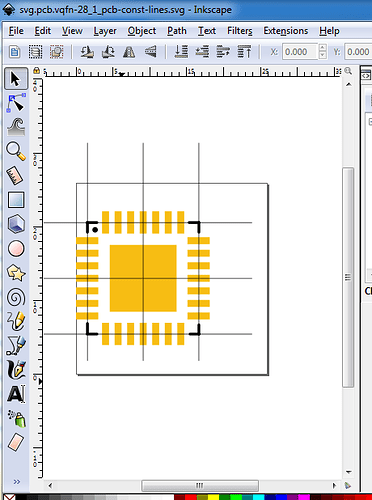Sure, not that hard. First find a qfn 28 footprint to start from in this case I used
fritzing-parts\svg\core\pcb\sparkfun-digitalic__stn_scantool_qfn-28-s_pcb.svg
from core parts. It is too big, 0.065mm pitch (needs 0.045 pitch) so edit in Inkscape. Get the recommended footprint from
page 12
pin 28 body 4x4 pitch 0.45 (which matches the data sheet)
adjust the pads and thermal pad to match this layout in Inkscape (used the data sheet thermal pad size not the footprint pdf one as it is specific to IC)
change connector0 from
w 8.5mm h 0.35mm
to
w 0.8mm h 0.25mm
repeat on connector 27 (the alternate orientation)
save the svg and edit the svg with vi. copy the height and width of connector0 and connector27 to all their same pins so all the pins are the correct size (but not the correct pitch or position yet.) Edit the modified svg with Inkscape. Set construction lines like this:
(the real svg appears to be too small for the forum to upload, so I’ll use an fzpz file later.) Now move the center pin to be centered in x and y with the center lines, then adjust the pins above and below (by changing their x and y values in the tool bar) to be on 0.45mm pitch. Then remove the construction lines, edit select all, resize page to drawing. Now regroup the silk screen and copper1 layers and save as plain svg.
VQFN-28-footprint.fzpz (3.1 KB)
if you download and unzip the .fzpz file you will get two svgs:
svg.pcb.vqfn-28_1_pcb.svg
which is the footprint you want and
svg.pcb.vqfn-28_1_pcb-const-lines.svg
which is the image above with the construction lines present to see how I did it. The original svg I used will be in your Fritzing core parts directory. To use the footprint it is probably easiest to use parts editor on the generic IC (it needs to be a 28pin smd of some kind) and replace the pcb svg with svg.pcb.vqfn-28_1_pcb.svg above. You can (which is what I would usually do ![]() ) also create the generic IC in the mine parts bin, then right click it and export part to write the fzpz file. Unzip that file and copy svg.pcb.vqfn-28_1_pcb.svg in to the pcb.svg.xxxxx.pcb file in the unizipped directory and rezip it as a .fzpz file and reload it in to Fritzing. As to parts making tutorials these two apply to the latest Fritzing version:
) also create the generic IC in the mine parts bin, then right click it and export part to write the fzpz file. Unzip that file and copy svg.pcb.vqfn-28_1_pcb.svg in to the pcb.svg.xxxxx.pcb file in the unizipped directory and rezip it as a .fzpz file and reload it in to Fritzing. As to parts making tutorials these two apply to the latest Fritzing version:
Peter
